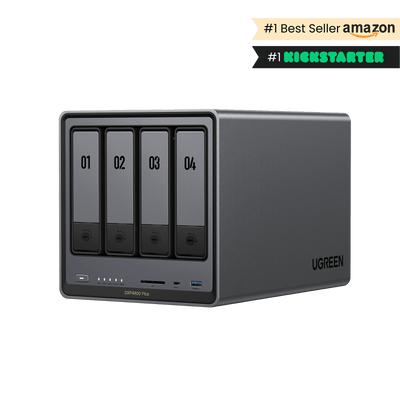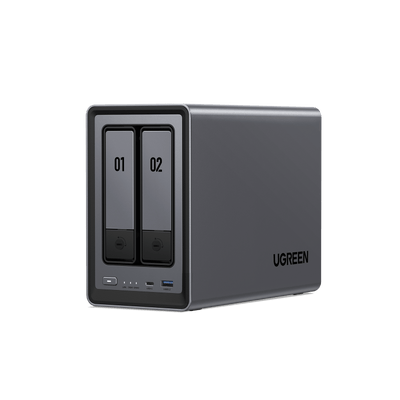How to Fix Slow NAS Speeds in 2025 (November 2025 Update)
What Speeds Should I Expect? My NAS Is Slow?
Help request from a Reddit user: My DXP4800 Plus is connected via 10 GBPS port to my Router (TPLink Deco BE85 - Wifi 7 Router). I then have a desktop computer hardwired to that same router to the 2nd 10 GBPS port and am trying to transfer a 500 GB folder over my local network. I am getting only 90 MBPS. I feel like it should be higher? I had to let it run a few hours to transfer it all. (This problem description is quoted from a post by a Reddit user.)
The problem isn’t always the NAS itself. More often, the culprit is your network, your cables, or even the devices you’re using. In this guide, we’ll uncover the real reasons behind slow NAS transfers and show you how to diagnose and fix them, one bottleneck at a time.

Top Reasons for Slow Speeds:
- NAS transfer speeds depend on the weakest link—your network, cables, client devices, or NAS hardware must all support the desired speed (e.g., 10GbE NAS needs matching routers, switches, and adapters).
- Hard drive performance sets a hard ceiling—even with 10GbE networking, a standard HDD typically maxes out at 100–200 MB/s, and RAID configurations can further reduce write speeds.
- File count and size dramatically affect real-world throughput—transferring thousands of small files incurs heavy metadata overhead, often dropping speeds to 10–30 MB/s on mechanical drives.
- Wired connections outperform Wi-Fi—Ethernet provides stable, near-maximum speeds, while Wi-Fi introduces latency and interference, especially for large file transfers.
- Software and settings can throttle performance—outdated firmware, disabled Jumbo Frames, or background tasks may artificially limit your NAS’s potential.
- Hardware compatibility is non-negotiable—ensure cables (Cat6a+), network ports, and client adapters all support your target speed tier (2.5GbE/10GbE).
Understanding NAS Transfer Speeds
Before we dive into solutions, we need to understand how transfer speeds work and why they’re so often misunderstood. Speed isn’t just a number on a spec sheet; it’s a dynamic outcome of multiple factors working together (or against each other).
How NAS Transfer Speeds Are Measured
At its core, NAS transfer speed is about how quickly data moves between your NAS and your other devices. It’s typically measured in megabytes per second (MB/s) for file transfers or gigabits per second (Gbps) for network infrastructure.
But here’s the catch: the advertised speeds reflect ideal conditions: a perfect network, top-tier hardware, and no competing traffic. In reality, your performance is always dictated by the weakest link in your entire system.
Quick Tip: Gbps vs. MB/s
Network speeds are in gigabits (Gb), while file sizes are in megabytes (MB) or gigabytes (GB). There are 8 bits in a byte, so to get a rough idea of real-world file transfer speed, divide the network speed by 8.
- 1 Gbps Network ≈ 125 MB/s max transfer speed
- 2.5 Gbps Network ≈ 312.5 MB/s max transfer speed

Key Factors Influencing Transfer Speeds
So, what are these “traffic jams” in your NAS setup? The usual suspects include:
- Network Infrastructure: Your router, switch, and cables must support the NAS’s speed. A 10GbE NAS plugged into a 1GbE router is like a sports car stuck in a school zone.
- Client Devices: Your computer or laptop needs a network adapter that can keep up. An old 1GbE adapter won’t unlock a 2.5GbE NAS’s potential.
- NAS Hardware: The NAS’s own CPU and RAM matter. An underpowered NAS will struggle to process data fast enough, even with a high-speed port.
- Software and Configuration: Outdated firmware or misconfigured settings can artificially throttle performance.
{{UGPRODUCT}}
Upgrading to a 10GbE NAS won’t magically fix slow speeds if the rest of your network can’t handle it. The key isn’t just to chase higher numbers, but to ensure your entire setup is balanced and optimized.
The Network: Foundation of Your NAS Performance
Think of your network as the stage and your NAS as the star performer. Even the most brilliant performance will fall flat on a poorly built stage.
Router and Switch Compatibility
Your router and switch are the unsung gatekeepers of your network’s pace. A NAS boasting a 10GbE port will be hobbled if it’s connected to a standard 1GbE router. To unleash your NAS’s full potential, look for “multi-gigabit” routers or switches that explicitly support 2.5GbE, 5GbE, or 10GbE speeds.
Choosing the Right Cabling
Don’t let your cables be an afterthought. Pairing a multi-gigabit NAS with old Cat5 cables is a recipe for disappointment. For 2.5GbE speeds, Cat5e is the minimum, but Cat6 or Cat6a will provide a more reliable connection and future-proof your setup. Quality, well-shielded cables also fend off electrical interference, ensuring your data flows unimpeded.
Ensuring Client Devices Can Keep Up
If your laptop’s network adapter tops out at 1GbE, that’s your speed ceiling, no matter how fast your NAS is. Check your computer’s network capabilities. If needed, you can upgrade its internal adapter or use a simple USB-to-2.5GbE (or faster) dongle, a modest investment with a potentially huge impact.
Troubleshooting Network Slowdowns
When performance lags, diagnose before you guess. Check the negotiated link speed on both your NAS and your computer (it’s usually displayed in your network settings). If it’s lower than expected, scrutinize your cables, switch ports, and router settings to find the bottleneck. For a deeper dive into pinpointing slowdowns and optimizing throughput, see our detailed guide on NAS performance issues and solutions.
The Hardware: Powering Your NAS
Your NAS’s hardware is the engine that drives its performance. Its ability to serve and write data hinges on its CPU and RAM.
The Role of CPU and RAM
A NAS is essentially a small, specialized computer. Its CPU processes file requests and manages network traffic, while its RAM acts as a temporary buffer for data in transit. A more powerful CPU can juggle multiple user requests smoothly, and more RAM allows it to handle larger files or more concurrent transfers without hitting a wall.
Hard Drives Set the Speed Limit
Even with a 10GbE network and a powerful processor, your NAS can’t transfer data faster than your hard drives can read or write it. A typical 7200 RPM mechanical hard drive delivers only 100–200 MB/s in real-world sequential transfers. So if you’re copying a large file from a single-drive volume or a RAID 1 array, hitting 90–150 MB/s is actually normal—not a sign of failure.
RAID configurations also play a role: RAID 5 or RAID 6 adds parity calculations that can slow down writes, especially during initial syncs or rebuilds. To truly unlock multi-gigabit speeds, consider using SSD caching (available on the via its dual M.2 NVMe slots) or creating a dedicated SSD storage pool for high-performance workloads like photo editing or 4K video streaming. If you’re weighing different RAID levels for your setup, our guide to choosing the best RAID for NAS explains how RAID 1, 5, 6, and 10 impact both speed and resilience.
File Count and Size Matter More Than You Think
Transfer speed isn’t just about bandwidth—it’s also about how your files are organized. Moving one 500 GB video file will feel blazing fast, but transferring the same amount of data as hundreds of thousands of small files (like photos, documents, or code snippets) can feel painfully slow.
Why? Each file requires separate operations: checking permissions, updating directories, and seeking physical locations on the disk. Mechanical drives struggle with this “random I/O,” often dropping effective speeds to 10–30 MB/s—not because your network is broken, but because the system is busy managing overhead, not moving data.
Pro tip: For bulk transfers of many small files, try compressing them into a single ZIP or TAR archive first. This turns thousands of tiny operations into one large, efficient transfer—and can cut your copy time by 5x or more.
Assessing Your NAS Hardware
As a rough guide, a dual-core CPU and 2GB of RAM might be enough for basic file storage for one or two users. However, if you use your NAS for media streaming, running apps like Plex, or supporting multiple simultaneous users, you’ll benefit from at least a quad-core CPU and 4GB of RAM or more.
Related reading: How to Install Plex on a NAS?
When to Consider an Upgrade
If your setup feels limited or you’re unsure whether it’s time to expand, it’s worth considering whether a 2-bay or 4-bay NAS better suits your needs. This guide on choosing between 2-bay and 4-bay NAS for media storage can help you weigh flexibility, performance, and future scalability. Understanding the trade-offs can save you from overbuying or outgrowing your system too quickly.
The Software: Fine-Tuning for Peak Performance
Sometimes, the handbrake is purely digital. Your NAS’s operating system and network settings are filled with powerful tools that can either unleash or limit its speed.
Optimizing with Jumbo Frames
In networking, data travels in packets. Standard packets are small, which can create processing overhead. Jumbo Frames allow for much larger packets (increasing the MTU, or Maximum Transmission Unit, from 1500 to 9000), reducing the number of “trips” needed and speeding up throughput. However, your entire network path (NAS, switch, router, and client device) must have Jumbo Frames enabled to work.
Managing NAS Resources
Your NAS is a multitasker, but every app, media server, and backup service sips from the same pool of CPU and RAM. Too many active tasks can choke performance. Use your NAS’s management interface to monitor its resource usage. If you see CPU or RAM spiking during transfers, identify the culprit. Disable or reschedule non-essential services like file indexing or antivirus scans for off-hours.
Troubleshooting Configuration Issues
When speeds lag unexpectedly, software glitches are often the hidden gremlins. Check your NAS’s system logs for errors or network conflicts. A common pitfall is a background task like data scrubbing or a cloud sync job hogging all the resources. Schedule these intensive tasks for times when you’re not actively using the NAS. If all else fails, a simple reboot or a reset of the network settings can often clear up mysterious issues.
Wired vs. Wireless: A Clear Winner for Speed
In the quest for performance, the choice between a wired and wireless connection is less a debate and more a revelation.
Wi-Fi, for all its convenience, is a capricious ally. Its speeds fluctuate based on distance, walls, and interference from other devices. Even the fastest Wi-Fi 6 routers rarely sustain the stable, gigabit speeds a NAS craves. A wired Ethernet connection, by contrast, is like a dedicated, private highway for your data. It delivers consistent, near-maximum speeds with minimal interference.
Consider the math: a NAS with a 2.5GbE port can theoretically transfer data at over 300 MB/s. The very best real-world Wi-Fi setups struggle to deliver half of that consistently. Trying to transfer large files over Wi-Fi is like pouring a waterfall through a straw.
If speed and reliability are your goals, always choose a wired connection for your NAS and primary computer. It’s the single most effective change you can make.
The Road to Full Speed
Slow NAS transfers are frustrating, but they’re almost always fixable. The problem is rarely a single, catastrophic failure, but a series of small, overlooked bottlenecks.
Start by approaching it systematically. Test your network, check your cables, and look at what your client devices can handle. Then, peek under the hood of your NAS to see if background tasks are holding you back. By optimizing your setup one link at a time, from the cable to the software, you can unchain your NAS and finally get the speed you paid for.




